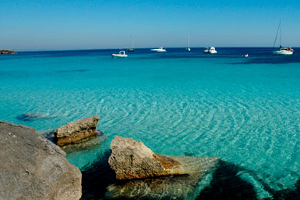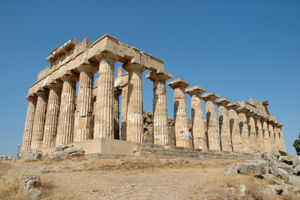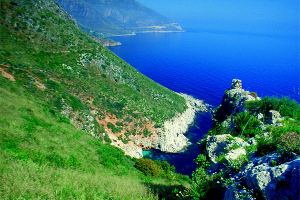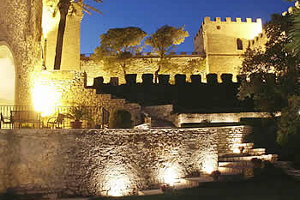The ancient seafaring village of San Vito is located on the promontory that closes the Gulf of Castellammare, between the Zingaro Nature Reserve and the Cofano Mountain. It extends along the coast and, because of its white sand, every summer, it becames a popular destination for anyone in the area. The present village began to take shape during the XVIII century around an ancient Shrine, dedicated to the martyr St. Vito, saint patron of the city. The Cous cous with fish is a typical dish to which, every year in September, is dedicated the Cous Cous Fest, the International Festival of Cous Cous.
The archipelago consists of three main islands, Favignana, Levanzo and Marettimo, and two uninhabited islands, Maraone and Formica. The surrounding sea is a Marine Nature Reserve.
Favignana is the largest, the most populous and, perhaps, the most famous of the three islands. It has an elongated shape, slightly closer to the center, which justifies its nickname of “butterfly”. In the half of the 800, it took on an increasing importance in the economic landscape of the area, due to the Florio family, who planted a big tunny-fishing nets, capable of spectacular seasons of slaughter( the famous “mattanza”). Today the ancient tradition of the massacre is renewed every year, continuing to be the most important event for the island. Splendide waters, small bays and the deep indescribable colors. The name of one of the most beautiful place of the island, Cala Rossa, remind us that the battle of the Egadi was fought in its waters, in 241 BC. On the top of the mountain, at 304 meters of altitude, you’ll see the Castle of S. Caterina, built by King Ruggiero in Norman times.
Levanzo, with its 5 km, is the smallest and the least populated island of the archipelago. A town with a few inhabitants and surrounded by high and rugged coastline that open on a clear sea. The appearance of the island is pretty wild, made of loops, caves and mountains. His greatest pride is the Grotta del Genovese: in its walls important graffiti of the the Upper Palaeolithic , representing men, animals, scenes of hunting and fishing, have been found. They represent also one of the oldest demonstration of tuna fishing in Sicily.
Marettimo is the farest of the three islands and even the most mountainous, at 37 km from the coast of Trapani. You cannot lose the island tour and the visit into the caves which open on its walls, descending on the sea. In the top of Punta Troia, you can clearly see the Castle, used by Arabs as a watch tower and then transformed in a prison. Inside of it William Pepper was imprisoned too.
Today the city of Selinunte doesn’t exist. But its greatness has survived. Between the VII and the V centuries it was one of the most flourishing and important Greek colonies, today is one of the most significative archaeological sites in Europe. Getting Selinunte, the vastness of the area on which it stands, the massive structure of columns, the richness of the decorations, the great number of ruins scattered on the ground and the solemnity of those ones still standing, will surprise you. Selinunte stood on a hillside not far from the sea that now falls in the town of Castelvetrano.
The Regional Nature Reserve Islands of the Stagnone of Marsala is a nature reserve of Sicily, created in 1984 in the territory of the town of Marsala. It extends on the west coast of Sicily in the Municipality of Marsala, in the stretch of the sea between Capo San Teodoro and Capo Boeo or Lilibeo, including the four islands of San Pantaleo (Mothia), Big Island, Shola and Santa Maria and salt coastal San Teodoro, Genna and Ettore Infersa. The reserve includes the “Lagoon”, that’s to say a lagoon(from which it takes its name), the largest of Sicily, characterized by a shallow (1-2 ft often, no more than 50 cm). As a result of movements of the sand of the lagoon , due to the underwater currents, the Grand Island has formed, around two originating islets. The birth of the island has closed a portion of sea originally open and here, as there is no current necessary for the exchange, the water has become stagnant, with a temperature above the normal.
The Zingaro Nature Reserve is a reserve managed by the Company Regional State Forests of the Sicilian Region. The coast of the Zingaro is one of the few stretches of Sicily coast which is not contaminated by the presence of a coastal road.
Erice is an Italian town of 28,534 inhabitants in the province of Trapani, in Sicily. A small and precious jewel in our province, is based on the summit of a mountain, at 751 m height, naturally preserved, solemn and solitary, not far away from Trapani. For centuries, the beauty of the views, the tranquility of the place and the mist, that often hides it from inquisitive looks, have made Erice a privileged place for the studies of scholars and the prayers of the monks. Made of narrow, winding, typically medieval arches, ornate courtyards and small shops,it still keeps unchanged its old charm. It has the shape of a perfect equilateral triangle, crowned on two vertices by the Castle of Venus, south-east, and the Mother Church, south-west. At the center, the church of San Domenico is now the seat of the prestigious International Center for Scientific Culture “Ettore Majorana”, focus of intensive scientific research, conducted by Prof. Antonino Zichichi, who founded it in 1963. The city is also famous for its particular typical confectionery, to which the nuns have dedicated themselves, since ancient times.
Segesta rises at a few kilometers from Alcamo and Castellammare del Golfo, in the Municipality of Calatafimi – Segesta, on the top of Mount Barbaro. Inaccessible from three sides, it was perfect for ancient populations, forced to defend themselves against their enemies. It is famous for what remains of its ancient splendor: the doric Temple, the Theatre and the Shrine of Contrada Mango. Every summer, in the beautiful scenery of the ancient Theater of Segesta, the great classics’ works of the theater revive. The city stood on two hills, on the top of Mount Barbaro. The city walls enclose two acropolis (North and South). Along the North Acropolis stands the theater. Outside the walls, you find the Temple, the Sanctuary of Contrada Mango and the remains of a Hellenistic necropolis. Beside the Acropolis stands the theater. Outside the walls, you find the Temple, the Sanctuary of Contrada Mango and the remains of a Hellenistic necropolis.







